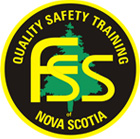Hooking Up For Transport
Hazards Identified
Crush injuries, back injuries
Hazard-Specific Personal Protective Equipment
CSA approved hard hat, CSA Grade I footwear, reflective vest, safety glasses with side shield
Hazard-Specific Training
Approved driver training course
Safe Work Practice
The following procedure shall be used when coupling Tractor-Semi-trailers.
- Conduct applicable inspection prior to coupling.
- Release tractor-parking brake and back the trailer slowly so the 5th wheel throat is in direct line with the kingpin under the front of the trailer or the equipment you are coupling up to. This is best done by aligning the tractor drive wheels with the side of the trailer while looking in the side mirrors.
- Stop, just before the 5th wheel makes contact with the front of the trailer. Apply parking brake.
- While standing along the tractor drive wheels, check the height of the trailer and raise or lower it as necessary. Check to see if jaws are open and that the pin is lines up with the 5th wheel. Do this from underneath and behind the tractor.
- Connect air lines and light cord. Align hose couplers with unit glad hands so that they are straight. Align light cord with the unit socket so that the raised area fits into socket, without forcing.
- Re-enter tractors cab, depress tractor protection valve and with your head out the window of door, listen for air exhausting at the rear of the unit. (This is to determine if the air lines are hooked up in the right order). Pull hands control lever down and hold it there to secure trailer brakes.
- Release trailer park brake.
- Back under unit so that 5th wheel jaw locks firmly around kingpin. Test the coupling by gently pulling the tractor forward.
- Apply tractor-parking brake. Release hand control valve.
- Check and double check front and rear of 5th wheel to determine that the jaws are properly closed around kingpin and that the safety lock or latch is in place.
- Crank up unit landing gear, reverse handle one full turn and secure handle on hanger strap in the “in” position. Crank legs 2” from ground before doing “tug test”.
- Return to drivers seat.
Regulations, Standards and References
Occupational Safety General Regulations
